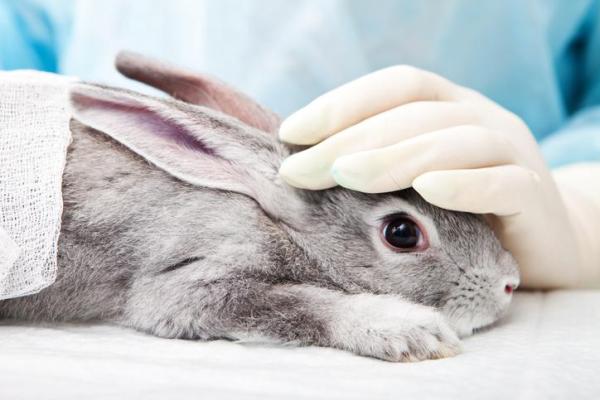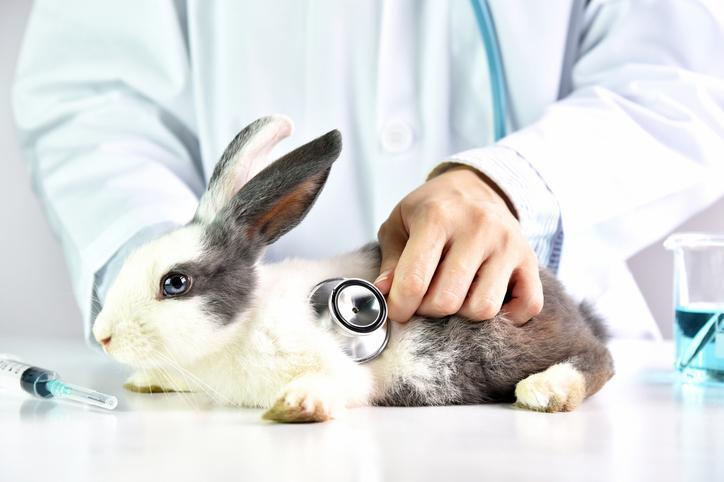My Rabbit has Heat Stroke - Signs and Treatment



See files for Rabbits
Before they become so popular as companion animals, rabbits had been used by humans in various cultures for their fur. The tri-layered fur of a rabbit's coat keeps the rabbit insulated against the often freezing temperatures of their natural habitat. While they will shed when the temperatures rise, they never lose their fur completely. This makes lagomorphs (the mammalian order of rabbits) particularly sensitive to the heat. Due to the diversity of domestic rabbit breeds, some have longer fur than others which can exacerbate the problem of overheating.
Due to the sun's strong rays, rabbit heat stroke can occur even when the temperature doesn't seem that high. This is why keeping an eye out for the symptoms is so important. If you find that your rabbit has heat stroke, you will also want to know what you can do about it in terms of treatment and prevention.
Symptoms of heat stroke in rabbits
Rabbits are sensitive to heat, generally being better able to thrive in cold climates compared to very hot environments. The vast majority of wild rabbits come from places which experience harsh winters such as Europe and the United States of America. This one of the reasons why many rabbits will spend so much time underground in burrows. The underground temperature remains relatively constant throughout the year[1].
Exposure to high temperatures and direct sunlight can easily affect the organism of rabbits. Not only can exposure lead to heat stroke, but it can result in sunburn and the risks associated with it. In fact, heat stroke is one of the most common health problems in rabbits.
The normal body temperature of rabbits varies between 30ºC and 40ºC (100ºF and 104ºF). This means the optimum environmental temperature for their development is between 18ºC and 24ºC (64ºF and 75ºF). A rabbit's body temperature will rise in cases where the ambient temperature exceeds 30ºC, they don't have any shady places to hide or if they don't have sufficient access to water. The result will be the emerging appearance of heat stroke in rabbits symptoms. These symptoms include:
- Panting
- Excessive salivation
- Weakness
- Reddened ears
- Stretching to have their body contact the ground
- Muscular tremors
- Tachycardia (increased heart rate)
- Lethargy
- Slow movements
- Wobbling
- Dizziness
- Seizures
When identifying any of these symptoms in your rabbit, it is essential to act quickly. You need to be conscious of what you need to do and apply the right form of first aid to the rabbit. Doing so is necessary as heat stroke can result in sudden death due to cardiac arrest. Next we will show you the steps you need to take if you suspect your rabbit has heat stroke.

My rabbit is breathing very fast, is it heat stroke?
Agitated breathing due to an increase in body temperature is one of the symptoms of heat stroke in rabbits. It will likely be accompanied by panting and dizziness. It should be noted that heat stroke is not the only illness associated with increased respiration. There are some other pathologies which may lead to breathing faster, but one condition in particular is quite prevalent.
Rabbits are sensitive animals and can respond acutely to various environmental factors. This can lead to stress in your rabbit. If you observe this kind of breathing in your rabbit, but they haven't been exposed to excess heat or sunlight, it could be stress. As there are many things which can lead to stress in rabbits, you will need to make an assessment of their lifestyle and environment to work out the root cause. To help you do this, take a look at our article on signs of stress in rabbits.
First aid for heat stroke in rabbits
Before we detail the first aid procedure for heat stroke in rabbits, we need to remind you it is the action you need to take to stabilize the rabbit's medical picture. Once this is done, it is essential to take the rabbit to a specialized veterinarian as soon as possible to verify their state of health and carry out a full examination. They may need to apply some more specific treatment to prevent the symptoms from recurring.
Now we can review the steps to follow to relieve the symptoms of heat stroke in rabbits. We will also help you to find ways to refresh them from the sluggishness caused by heatstroke.
- Take them to a cooler environment: if your rabbit shows signs of heat stroke, they have either been in a very hot environment or have been directly exposed to too much solar radiation. To alleviate these symptoms, it is essential to take them to a cooler environment. This place should have plenty of shade and good ventilation to help reverse the effects of excessive heat. However, it is important to know you shouldn't try to rapidly decrease their temperature by using ice or something similarly very cold. Going from one extreme temperature to another can cause shock. If you use a fan to ventilate the place you take them to, do not aim it directly on the rabbit.
- Provide hydration: it is essential your rabbit stays well hydrated to avoid kidney damage or failure. Ensure there is plenty of fresh cool water available and within reach of the rabbit. If your rabbit is too weak, they may not be able drink water of their own accord. In these cases, you can't force them to drink. Instead, you should moisten their mouth with the help of a diffuser. If you do not have a diffuser, soak some clean gauze or cotton in clean water and set it on their lips.
- Gently refresh their body: the next step to take will be to refresh the rabbits body to gently reduce their body temperature (not abruptly). To do this moisten a clean cloth or gauze and pass it gently over the rabbit's body. Move over the belly, head, neck, chest, legs and, very carefully, on the hairless part of heir ears. Be careful not to drip water into their ears. Never use ice to cool your rabbit as this can cause shock when the temperature drops too quickly.
- Moisten their mouth again: re-soak your rabbit's mouth periodically to ensure they are having the opportunity to stay hydrated. Again, do not force them to drink.
- Seek veterinary help: after applying first aid, go to a veterinarian who is specialized in rabbit care. Phone ahead and take them to the right place.

How to prevent heat stroke in rabbits
Preventing heat stroke is rabbits is necessary to preserve the good health of your rabbit. While a rabbit may recover from heat stroke, it can add stress and trauma to their life which will negatively impact them. The effects of this impact may last for a long time. To prevent heat stroke, we recommend the following:
- Don't leave your rabbit confined: you may need to take your rabbit to travel or leave them in a hutch for their safety, but be careful with confined spaces. In places with poor ventilation and confined walls, temperatures rise more easily and your rabbit is more susceptible to heat stroke. Let them have air as much as possible and provide shady areas for them to retreat.
- Brush regularly: especially with long hair breeds, you will need to keep your rabbit's coat in good condition. Regular brushing will help to get rid of excess hair, keeping them cooler i warm temperatures. They may shed naturally, but brushing will help this process along. it also helps to prevent other problems such as hairballs.
- Always provide clean fresh water: while hydration is important year-round, it is particularly required during hotter days. Pay attention to the water levels, keep the water in a shaded place and replenish their dishes/bottles regularly with fresh clean water.
- Regulate their meal times: during the warm summer months, try to feed the rabbit in the coolest parts of the day with the least direct sunlight. Dusk is a particularly good time. Remember to provide a complete and balanced diet for your rabbit.
- Prevent obesity: obese animal are more susceptible to heat. They are also more likely to develop certain pathologies associated with being overweight and a sedentary lifestyle. In addition to providing a balanced diet, remember to respect the amount of food they require daily appropriate to their size, breed, health status and age. For example, dwarf rabbits will need less food than larger breeds. Opportunity for exercise and stimulation is also imperative.
- Preventive medicine: rabbits also need to receive adequate preventive medicine in order to stay healthy and better protect themselves against heat stroke, We advise you make a visit to the vet before the arrival of summer to ensure they are in good condition and have their vaccinations and anti-parasitical treatments up to date. This should be done again just before winter for a general health checkup.

This article is purely informative. AnimalWised does not have the authority to prescribe any veterinary treatment or create a diagnosis. We invite you to take your pet to the veterinarian if they are suffering from any condition or pain.
If you want to read similar articles to My Rabbit has Heat Stroke - Signs and Treatment, we recommend you visit our First aid category.







